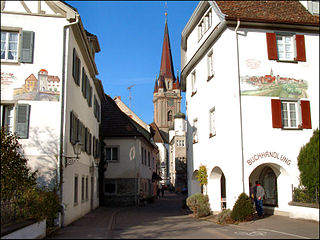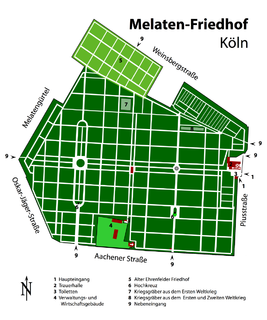Strife in Wehr
In the beginning of the 19th century there were 19 families with the name Trefzger in Wehr. The Trefzger family was the second largest in Wehr. In 1833, the law changed for servants, from being owned by landlords to now having a chance to buy their way out and be independent. In 1834, a commission of the mayor Berger and his council members (one of them was a Trefzger) worked out a plan for this matter. There was a problem, however, with Martin Trefzger. He was a teacher, city council secretary and one of the twelve landowners who had to be paid off accordingly. He and another landlord disagreed about how much the city should pay them at this buy-out. The fight between Trefzger and the commission came finally to an end in 1840. Enkendorf, part of Wehr, tried to secede from Wehr. Enkendorf claimed to have enough citizens (90) to receive its independence from Wehr (410 citizens). Against the independence of Enkendorf was the city council of Wehr, with members like Sebastian Trefzger and Karl Berger, as lawyers, and the scriptor (secretary) of law, Martin Trefzger. Revolution in 1848 in Wehr: In 1847, the movement to create a republic in Baden began to increase dramatically. The idea started in France based on the July Revolution in 1830 against Napoleon III. The government of Baden started, therefore, in 1848, a citizen patrol to calm this political movement down. Two of the leaders of the movement were Frans Joseph Trefzger and Hecker. The radicals declared a ‘German Republic’ on September 21, 1848. Many citizens, and finally the Prussian army troupes, fought against the radicals. So did Wolfgang Trefzger, who belonged to the mayor's council. Frans Joseph Trefzger and his movement finally gave up in May, 1849. Some political activists emigrated to Switzerland and to America.

Calw is a town in the middle of Baden-Württemberg in the south of Germany, capital and largest town of the district Calw. It is located in the Northern Black Forest and is approximately 18 km (11 mi) south of Pforzheim and 33 km (21 mi) west of Stuttgart. It has the status of a große Kreisstadt.

Radolfzell am Bodensee is a town in Germany at the western end of Lake Constance approximately 18 km northwest of Konstanz. It is the third largest town, after Constance and Singen, in the district of Konstanz, in Baden-Württemberg.

Brühl is a municipality in the Rhein-Neckar district of Baden-Württemberg, Germany. The former fishing village along the Rhine has become a satellite of a growing Mannheim. Many of the residents of Brühl work in Mannheim. Brühl is known as the hometown of former tennis player Steffi Graf.

The University of Strasbourg is a public research university located in Strasbourg, Alsace, France, with over 52,000 students and 3,300 researchers.

A Burschenschaft is one of the traditional Studentenverbindungen of Germany, Austria, and Chile . Burschenschaften were founded in the 19th century as associations of university students inspired by liberal and nationalistic ideas. They were significantly involved in the March Revolution and the unification of Germany. After the formation of the German Empire in 1871, they faced a crisis, as their main political objective had been realized. So-called Reformburschenschaften were established, but these were dissolved by the Nazi regime in 1935/6. In West Germany, the Burschenschaften were re-established in the 1950s, but they faced a renewed crisis in the 1960s and 1970s, as the mainstream political outlook of the German student movement of that period swerved to the radical left. Roughly 160 Burschenschaften exist today in Germany, Austria and Chile.

Weinheim is a town with about 43,000 inhabitants in northwest Baden-Württemberg, Germany. It is in the Rhine-Neckar Metropolitan Region, approximately 15 km (9 mi) north of Heidelberg and 10 km (6 mi) northeast of Mannheim. Weinheim is known as the "Zwei-Burgen-Stadt", the "town of two castles", after two fortresses overlooking the town from the edge of the Odenwald in the east.

Offenburg is a city located in the state of Baden-Württemberg, Germany. With nearly 60,000 inhabitants (2019), it is the largest city and the administrative capital of the Ortenaukreis.

Wehr is a town in the Waldshut district in Baden-Württemberg, Germany. It is situated 9 km north of Bad Säckingen, and 18 km east of Lörrach. Wehr is the home of two very old and large families: the Trefzgers and the Nagelins.
The Baden Revolution of 1848/1849 was a regional uprising in the Grand Duchy of Baden which was part of the revolutionary unrest that gripped almost all of Central Europe at that time.

Melaten is the central cemetery of Cologne, North Rhine-Westphalia, which was first mentioned in 1243. It was developed to a large park, holding the graves of notable residents.

Schottengymnasium is a Catholic private gymnasium with public status in the First District of Vienna. The school was founded in 1807 by imperial decree, and it is considered one of the most prestigious grammar schools in Austria. Alumni of the school include three Nobel laureates, many notable politicians, artists and scientists.

The State Academy of Fine Arts Stuttgart is a university in Stuttgart, Germany. Founded on 25 June 1761, and located since 1946 on the Weißenhof, the Academy, whose historical significance marks names such as Nicolas Guibal, Johann Heinrich von Dannecker, Bernhard Pankok, Adolf Hölzel, Willi Baumeister, Herbert Hirche, K.R.H. Sonderborg, Alfred Hrdlicka, Heinz Edelmann, Marianne Eigenheer, Richard Sapper, Joseph Kosuth, David Chipperfield, Joan Jonas, Micha Ullman, offers from all art universities in the federal state Baden-Württemberg the largest numbers of courses, namely all disciplines of the visual field, and not just in an organizational network but also under one roof. This is essentially the result of the connection of the former Academy of Fine Arts with the former School of Applied Arts in 1941 as Staatliche Akademie der bildenden Künste Stuttgart, which was reconstituted by Theodor Heuss in 1946 under the same name and which aimed at a broad training program as well as an intensified development in the following decades. Under the rectorate of Wolfgang Kermer, on 22 February 1975, the ″Gesetz über die Kunsthochschulen im Lande Baden-Württemberg (Kunsthochschulgesetz)″ passed by the Landtag of Baden-Württemberg came into force, which for the first time in the history of the State Academy of Fine Arts Stuttgart regulated the status and the essential relationships and which guaranteed the equality of rank with universities.

The Hauptfriedhof in Karlsruhe is one of the oldest German communal rural cemeteries. In 1871, the first plans to build a new burial ground outside the city center began. The cemetery was laid out in 1874 by Josef Durm in the Rintheim district, east of the actual city, after the inner-city Alter Friedhof Karlsruhe in the Oststadt had become too small. The main cemetery has grown from its original size of 15.3 hectares in 1873 to over 34 hectares. The graves of more than 32,000 deceased are currently in the cemetery.
This page is based on this
Wikipedia article Text is available under the
CC BY-SA 4.0 license; additional terms may apply.
Images, videos and audio are available under their respective licenses.











